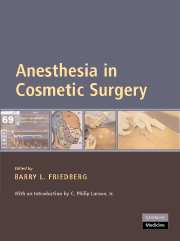Book contents
- Frontmatter
- Contents
- Foreword
- Acknowledgments
- Introduction
- Preface
- List of Contributors
- PART I MINIMALLY INVASIVE ANESTHESIA (MIA)Ⓡ FOR MINIMALLY INVASIVE SURGERY
- PART II ALTERNATIVE ANESTHESIA APPROACHES IN COSMETIC SURGERY
- PART III OTHER CONSIDERATIONS FOR ANESTHESIA IN COSMETIC SURGERY
- 14 Preanesthetic Assessment of the Cosmetic Surgery Patient
- 15 Psychological Aspects of Cosmetic Surgery
- 16 The Business of Office-Based Anesthesia for Cosmetic Surgery
- 17 The Politics of Office-Based Anesthesia
- 18 Staying Out of Trouble: The Medicolegal Perspective
- APPENDIX A A Guide to Perioperative Nutrition
- APPENDIX B Reflections on Thirty Years as an Expert Witness
- Index
- References
14 - Preanesthetic Assessment of the Cosmetic Surgery Patient
from PART III - OTHER CONSIDERATIONS FOR ANESTHESIA IN COSMETIC SURGERY
Published online by Cambridge University Press: 22 August 2009
- Frontmatter
- Contents
- Foreword
- Acknowledgments
- Introduction
- Preface
- List of Contributors
- PART I MINIMALLY INVASIVE ANESTHESIA (MIA)Ⓡ FOR MINIMALLY INVASIVE SURGERY
- PART II ALTERNATIVE ANESTHESIA APPROACHES IN COSMETIC SURGERY
- PART III OTHER CONSIDERATIONS FOR ANESTHESIA IN COSMETIC SURGERY
- 14 Preanesthetic Assessment of the Cosmetic Surgery Patient
- 15 Psychological Aspects of Cosmetic Surgery
- 16 The Business of Office-Based Anesthesia for Cosmetic Surgery
- 17 The Politics of Office-Based Anesthesia
- 18 Staying Out of Trouble: The Medicolegal Perspective
- APPENDIX A A Guide to Perioperative Nutrition
- APPENDIX B Reflections on Thirty Years as an Expert Witness
- Index
- References
- Type
- Chapter
- Information
- Anesthesia in Cosmetic Surgery , pp. 171 - 181Publisher: Cambridge University PressPrint publication year: 2007
References
- 2
- Cited by

